China announces "2019 archaeological discoveries of the year"
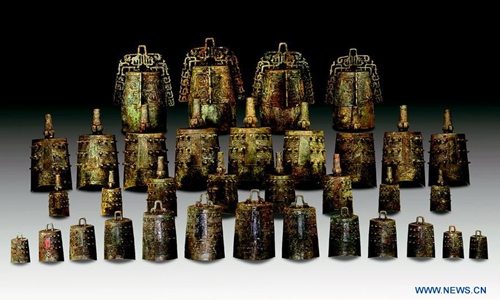
File photo shows bronze chime bells excavated from a tomb of the Spring and Autumn Period (770-476 BC) in Suizhou City, central China's Hubei Province. A total of six archaeological projects were made public by the Institute of Archaeology of the Chinese Academy of Social Sciences (CASS) on Friday as "China's 2019 archaeological discoveries of the year." The six laureate archaeological projects include a Neolithic site of Longshan Culture in east China's Shandong Province, a tomb of the Spring and Autumn Period (770-476 BC) in Hubei Province, and a tomb with frescos which dates back to Tibetan Tubo Kingdom (about 618-842) in the high-altitude Qinghai-Tibet Plateau. (Xinhua)
A total of six archaeological projects were made public by the Institute of Archaeology of the Chinese Academy of Social Sciences (CASS) on Friday as "China's 2019 archaeological discoveries of the year."
The six laureate archaeological projects include a Neolithic site of Longshan Culture in east China's Shandong Province, a tomb of the Spring and Autumn Period (770-476 BC) in Hubei Province, and a tomb with frescos which dates back to Tibetan Tubo Kingdom (about 618-842) in the high-altitude Qinghai-Tibet Plateau.
Nateshwar in the Vikrampura Ancient City in the People's Republic of Bangladesh was named the foreign archaeological discovery of 2019.
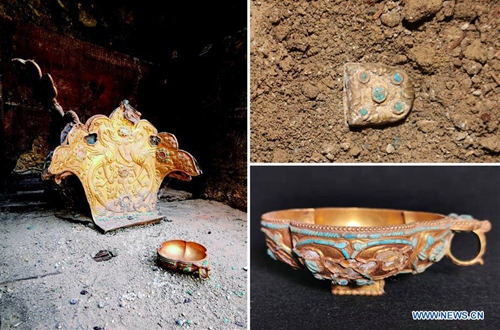
Combo file photo shows a turquoise inlaid gold ware excavated from a tomb with frescos which dates back to Tibetan Tubo Kingdom (about 618-842) in Wulan County, northwest China's Qinghai Province. A total of six archaeological projects were made public by the Institute of Archaeology of the Chinese Academy of Social Sciences (CASS) on Friday as "China's 2019 archaeological discoveries of the year." The six laureate archaeological projects include a Neolithic site of Longshan Culture in east China's Shandong Province, a tomb of the Spring and Autumn Period (770-476 BC) in Hubei Province, and a tomb with frescos which dates back to Tibetan Tubo Kingdom (about 618-842) in the high-altitude Qinghai-Tibet Plateau. (Xinhua)
During the archaeology forum of the CASS Institute of Archaeology on Friday, expert representatives delivered presentations to introduce the awarded archaeological projects from multiple aspects, such as the archaeological background, process of excavation, main achievements and the academic significance.
The forum, initiated in 2002, is considered as a platform for exchanging information, presenting new findings and academic lectures of archaeology due to its wide recognition and high professional standards.
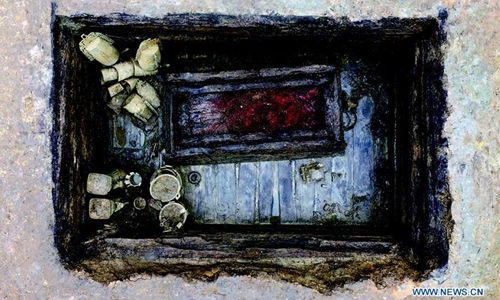
File photo shows a tomb of the Spring and Autumn Period (770-476 BC) in Suizhou City, central China's Hubei Province. A total of six archaeological projects were made public by the Institute of Archaeology of the Chinese Academy of Social Sciences (CASS) on Friday as "China's 2019 archaeological discoveries of the year." The six laureate archaeological projects include a Neolithic site of Longshan Culture in east China's Shandong Province, a tomb of the Spring and Autumn Period (770-476 BC) in Hubei Province, and a tomb with frescos which dates back to Tibetan Tubo Kingdom (about 618-842) in the high-altitude Qinghai-Tibet Plateau. (Xinhua)
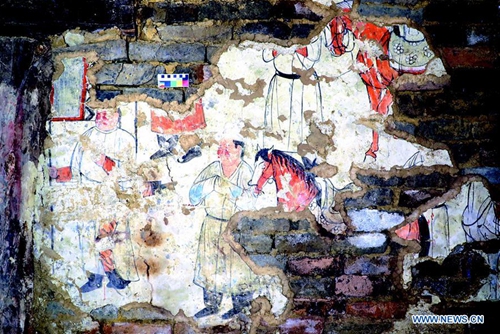
File photo shows a fresco in a tomb which dates back to Tibetan Tubo Kingdom (about 618-842) in Wulan County, northwest China's Qinghai Province. A total of six archaeological projects were made public by the Institute of Archaeology of the Chinese Academy of Social Sciences (CASS) on Friday as "China's 2019 archaeological discoveries of the year." The six laureate archaeological projects include a Neolithic site of Longshan Culture in east China's Shandong Province, a tomb of the Spring and Autumn Period (770-476 BC) in Hubei Province, and a tomb with frescos which dates back to Tibetan Tubo Kingdom (about 618-842) in the high-altitude Qinghai-Tibet Plateau. (Xinhua)
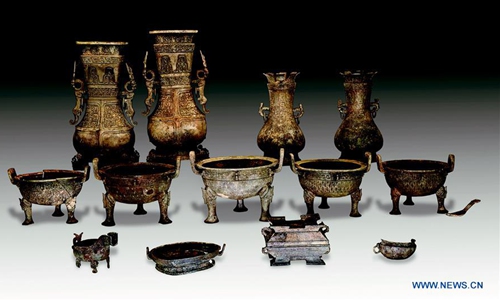
File photo shows bronze vessels excavated from a tomb of the Spring and Autumn Period (770-476 BC) in Suizhou City, central China's Hubei Province. A total of six archaeological projects were made public by the Institute of Archaeology of the Chinese Academy of Social Sciences (CASS) on Friday as "China's 2019 archaeological discoveries of the year." The six laureate archaeological projects include a Neolithic site of Longshan Culture in east China's Shandong Province, a tomb of the Spring and Autumn Period (770-476 BC) in Hubei Province, and a tomb with frescos which dates back to Tibetan Tubo Kingdom (about 618-842) in the high-altitude Qinghai-Tibet Plateau. (Xinhua)
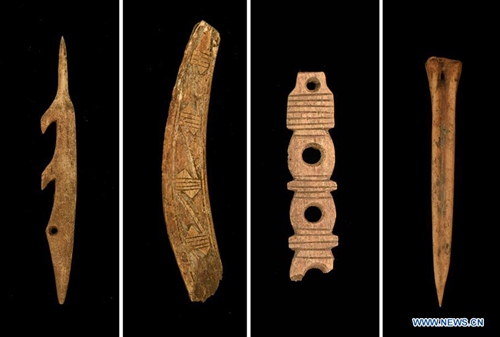
Combo file photo shows bone artifacts excavated from the Honghe ruins in Qiqihar, northeast China's Heilongjiang Province. A total of six archaeological projects were made public by the Institute of Archaeology of the Chinese Academy of Social Sciences (CASS) on Friday as "China's 2019 archaeological discoveries of the year." The six laureate archaeological projects include a Neolithic site of Longshan Culture in east China's Shandong Province, a tomb of the Spring and Autumn Period (770-476 BC) in Hubei Province, and a tomb with frescos which dates back to Tibetan Tubo Kingdom (about 618-842) in the high-altitude Qinghai-Tibet Plateau. (Xinhua)